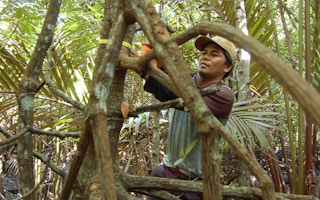The dry season of 2015 was a devastating one for Indonesia, with around 100,000 fires engulfing thousands of hectares of tropical rainforests and carbon-rich peatlands on the islands of Sumatra, Borneo and New Guinea.
The infernos, strengthened by dry weather caused by El Niño, raged for months, in the process emitting more carbon dioxide than a year’s worth of US economic activity. The haze spread so far it threatened public health not just in Indonesia, but also in Singapore, Malaysia and Thailand, leading an Indonesian government agency to label the fires a “crime against humanity.”
While the 2015 fires were particularly severe, reports of such tropical forest fires in Indonesia, especially Borneo, have hit headlines almost every year for decades. A recent study predicts that as climate change worsens and deforestation intensifies in the region, the risk of forest fires will only continue to increase.
The study, published in the journal Environmental Research Letters, calculated the combined effect of climate change and deforestation on fire risk in Borneo, and found that while high levels of CO2 in the atmosphere increase fire risk, deforestation, which causes the dry conditions that fuel the fires, significantly contributes to it.
Growing risk of fires
As the planet warms, wildfires have become increasingly frequent and intense across the world. Tropical forests, which greatly impact the local climate, temperature and rainfall, cover more than half of Kalimantan, the Indonesian part of Borneo.
In the past few decades, about a third of these tropical forests have been cut down to make way for oil palm and rubber plantations, often using slash-and-burn practices that can spark out-of-control fires. The draining of perennially water-bogged peatlands has made conditions on the ground even more conducive for fires.
“
These results strengthen the already clear argument that retaining primary forest is a win-win for climate mitigation as well as other aims, like ecology.
Taraka Davies-Barnard, climate modeller, University of Exeter
While previous studies have established the role of climate change and deforestation in increased fire risk, this study projects their combined effects into the future.
“We use climate models with as fine a spatial scale as we can to actually make these predictions to see where the risk of fire increases,” says study author Frank van Veen from the University of Exeter, UK, who also leads Kalimantan Lestari, an interdisciplinary project focused on building resilience against drought and peatland fires in the province of Central Kalimantan.
The researchers simulated changes to Borneo’s climate with elevated levels of CO2 in the atmosphere in the business-as-usual scenario (also known as RCP8.5), and intensified deforestation where tree cover declined from 72 per cent in 2000 to 0 per cent by the end of the century. Then, they calculated the combined effect of elevated CO2 levels and complete deforestation to estimate variations in rainfall, temperature, humidity and winds — all of which determine fire risk.
The modelling indicates that around peatlands, which are at lower elevations, deforestation increases the peak level of fire risk during the dry season (June, July and August) more so than elevated atmospheric CO2 does. However, climate change increases the mean fire risk during this period. At high elevations, above 500 meters (1,640 feet), deforestation accounts for 53 per cent of the projected annual temperature increase for the 21st century. The models also predict an increase in extreme dry and wet years, rather than just an increase in the average temperature.
The findings show that while increased atmospheric CO2 due to climate change remains a greater threat to Borneo’s forests and peatlands, deforestation has a significant impact, even accounting for the possibility that deforestation could increase precipitation locally. “These results strengthen the already clear argument that retaining primary forest is a win-win for climate mitigation as well as other aims, like ecology,” says lead author and climate modeller Taraka Davies-Barnard, also from the University of Exeter.
The study provides new insights by exploring the impacts of both climate change and land-use change, says atmospheric scientist Min-Hui Lo from National Taiwan University, who was not involved in the research: “To my knowledge, not many studies show how the two things behave together.”
While the findings of the study rely on hypothetical future scenarios, they underlie how vital it is to act on deforestation to reduce the risk of devastating fires. “This is the bit that governments can really do something about,” van Veen says, noting that while local governments have little control over global climate change, they can still “affect their regional climate by managing the forest cover.”
To reverse the draining of peatlands and stem the loss of forests, Indonesia’s president established a peatland restoration agency in 2020, whose scope was later expanded to mangroves as well. And at the COP26 climate summit in Glasgow, Scotland, the Indonesian government pledged to end deforestation by 2030. While there has been some progress with peatland restoration since then, the government has walked back on its deforestation commitment. “It’s important that that commitment is maintained,” van Veen says, adding that deforested areas of peatland are “hugely sensitive to drought and fire.”
Each year, the burning of dried-out peatlands releases not just huge volumes of CO2, but also generates clouds of toxic haze that lead to the premature deaths of 33,100 adults and 2,900 infants. The haze is lined to more than half a million cases of asthma in children in Indonesia, mainly in Sumatra and Kalimantan. If fire risk increases as the study shows, a worrisome future awaits for Borneo and beyond.
This story was published with permission from Mongabay.com.










